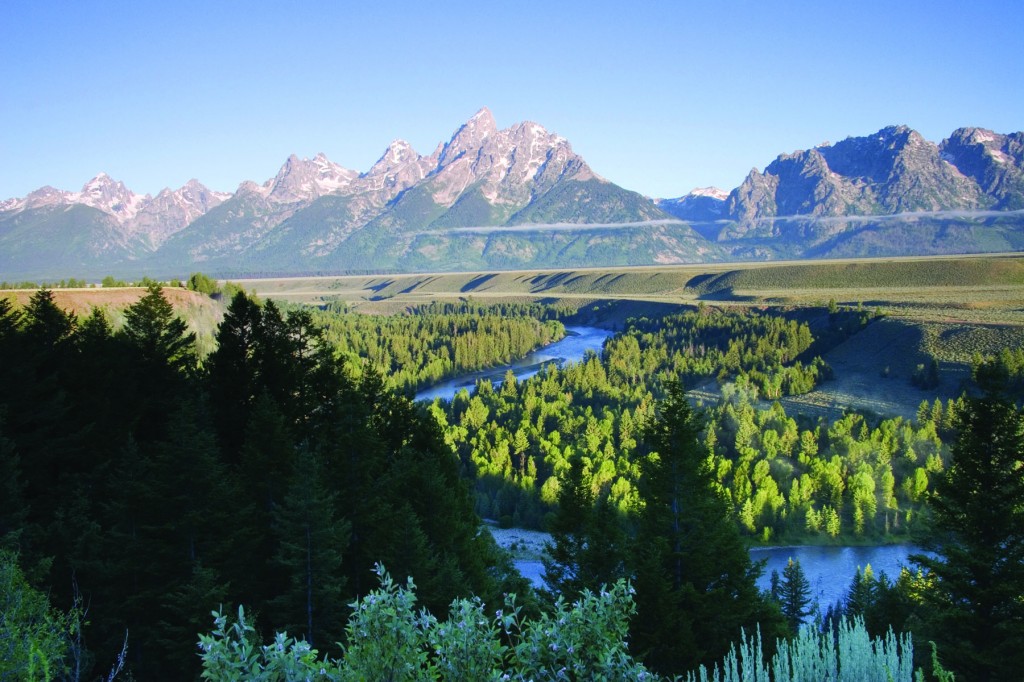Today Grand Teton National Park is one of the top ten visited national parks in the country and with good reason, as tourists, mountain climbers, skiers, fly fisherman, hikers, boaters, and more flock to this awe inspiring locale in northwestern Wyoming. But if it wasn’t for a well meaning conspiracy and an unforgettable lunch, Grand Teton National Park may have never become a reality, and instead would have been developed commercially as private land and homes with maybe even a Wal-Mart or two.
At around 480-square miles Grand Teton is not the biggest national park in the country, but may very well be one of the most scenic as visitors and locals alike never seem to get over the incredible view of mountains jutting straight out of the ground and onto the horizon. In fact if you flew into Jackson on a clear day, you probably got a great glimpse of these majestic mountains right out the airplane window. Jackson Hole Airport is the only airport in the nation to be located in a national park. You might be able to see the New York City skyline when you fly into Newark, but you’ll never see the Tetons or possibly moose or bald eagles when you walk off your plane and onto the tarmac (sorry New Jersey).
Grand Teton is often thought of as Yellowstone’s little sibling to the south, at just 10 miles away from the country’s first national park. You won’t be seeing geysers here, but Grand Teton is typically less crowded and offers unrivaled mountain views and wildlife sightings of just about anywhere in the lower 48 and the world.
What’s in a Name?
Native Americans were the first humans to settle in and around what is today known as Grand Teton. In the early to mid-1800’s fur traders made their way to this undeveloped area in search of sought after beaver pelts. The unsettled land and harsh climate made for a hard scrabble existence for those that came to seek their fortunes. The French speaking fur traders, a male dominated profession, must have been shall we say lonely and missing the company of women; as when they set their eyes on these unheralded peaks they proclaimed them the “Les Trois Tetons”which translates to the “The Three Breasts”. This original name eventually became shortened to Tetons, but the Grand Teton, the gem and largest mountain peak of the range at 13,775 feet literally translates to the “big breast”, oh those horny, or lonely fur trappers. It certainly has a certain je ne sais quoi to it, although it must certainly give our French speaking visitors a chuckle upon hearing a whole National Park devoted to it.
Park Origins
Yellowstone National Park Superintendent, Horace Albright, was concerned about the possible development of the unspoiled wilderness of Grand Teton in the forms of proposed dams and the construction of summer cabins. Although local opposition was opposed to taking the area of Grand Teton and incorporating it into the existing Yellowstone National Park, many locals were in favor of making the area its own national park. Albright met with East Coast tycoon John D. Rockefeller, Jr., who was visiting Yellowstone with his family. Albright drove them south to the Tetons one day for lunch and stopped at was is now known as “Lunch Tree Hill”(a short walk up from where Jackson Lake Lodge was built). It was here that Rockefeller had his “a-ha moment”. There is no mention of what was served at the picnic, so we must assume Rockefeller instantly fell in love with the view and not the potato salad and would later vow to protect this special place. The next day Albright took the Rockefeller’s further south and showed off Jenny Lake, Leigh Lake, and String Lake. The Rockefeller’s loved this area as well, but were shocked at the random and shoddy commercialism and development, specifically one rough and tumble dancehall which was a blight on this pristine landscape. When they asked what could be done, Albright confided in them in his plan to save and protect Grand Teton and a conspiracy was hatched.
Conspiracy to Protect
Rockefeller soon began to buy up land in Northern Jackson as if he was playing a game of Monopoly. When he was done the business tycoon had bought up well over 100,000 acres. Albright implored Rockefeller to keep this mass real estate land grab hush-hush to prevent inflation on land prices and to keep the well known tycoons name and purpose of the acquisition a secret. To enact this a front was formed in the name of the Snake River Land Company.
In 1929 President Calvin Coolidge signed Grand Teton National Park into law at half its size of today. In 1930 the “Snake River Land Company”was done buying land, yelled gotcha, and thus revealed its true intentions of adding this newly acquired land to Grand Teton National Park. Many felt duped by the conspiracy of Albright, a government worker, and Rockefeller, an eastern millionaire, and outrage ensued. It wouldn’t be until 1942 after Rockefeller, fed up and frustrated that his altruistic plan had yet to be enacted threatened to sell his acquired Jackson land. In 1943 FDR issued an order to turn this land into Jackson Hole National Monument. Congress enacted a bill to abolish this new monument and the state of Wyoming promptly filed suit against Jackson National Monument as well, claiming there was no just reason for this land to be a national monument. It wouldn’t be until 1950 when President Truman incorporated Rockfeller’s land holdings into what is now known as Grand Teton National Park today.
Because of a memorable picnic, a conspiracy was hatched to create a stunning national park. A park that is home to over sixty species of mammals, over 300 birds, six mountain lakes and numerous rivers as well as over four million annual visitors a year. We’d call that pretty much the best business lunch ever.

